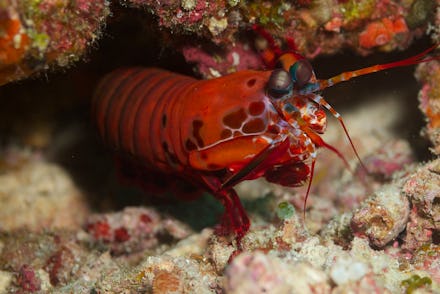Thanks to These Amazing Shrimp, Scientists Can Now "See" Cancer

The news: According to the World Health Organization, early detection is one of the most powerful weapons in the fight against cancer. What if you were just able to look at someone and see if they have cancer? That would be a pretty powerful tool, and now, thanks to a group of Australian researchers and one very amazing crustacean, that might be a real possibility.
New research from the University of Queensland in Australia has found that the eyes of the mantis shrimp, a crustacean that can reach up to 12 or 15 inches in length, have evolved to be "compound eyes," which have inspired a new type of camera scientists and doctors could potentially use to "detect a variety of cancers and visualize brain activity," according to a university release.
Special eyes: The researchers found that unlike human eyes, mantis shrimp eyes are amazingly tuned to detect polarised light, which reflect differently on different types of tissue, e.g., cancerous and healthy tissue.
"Humans can't see this, but a mantis shrimp could walk up to it and hit it," Justin Marshall of the Queensland Brain Institute at the University of Queensland said in a press release.
"We see color with hues and shades, and objects that contrast — a red apple in a green tree for example — but our research is revealing a number of animals that use polarised light to detect and discriminate between objects."
In order to harness this potentially game-changing ability, Marshall and his team worked with international collaborators to develop a camera that replicates the mantis shrimp's compound eye and can detect cancer-infected body tissue, thereby cutting down the need for more invasive procedures such as biopsies and giving greater accuracy to surgical procedures.
A Mantis Shrimp. Image Credit: Wikipedia/PD-USGOV
Nature engineering our own future: "Nature has come up with elegant and efficient design principles, so we are combining the mantis shrimp's millions of years of evolution — nature's engineering — with our relatively few years of work with the technology," Marshall said in the release. The camera, Marshall says, "converts the invisible messages into colors that our visual system is comfortable with."
Though the technology is still being developed, early iterations of the cameras have already been successful in "seeing" real-time neuron activity inside a human brain, as well as providing early detection of cancer in mice.
In time, the researchers believe, the technology can be improved and honed to the point where it could be included in a smartphone, potentially giving millions of people the technological ability to quickly and easily detect their own cancer growths, thereby greatly reducing this burden on health systems and providing a very powerful weapon in the fight against cancer. Imagine one minute taking a selfie and the next screening yourself for cancer — that's the kind of future everyone would be happy to live in.
h/t Science Alert